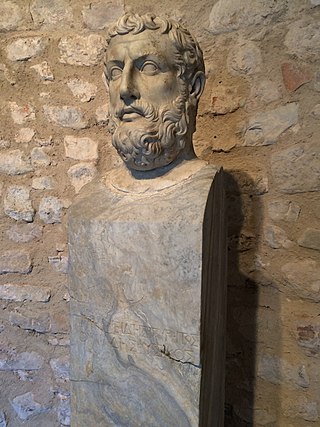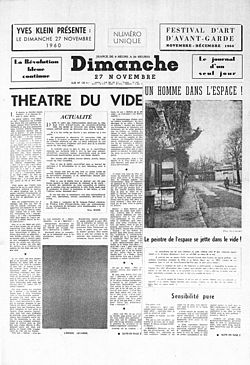Related Research Articles

Anaxagoras was a Pre-Socratic Greek philosopher. Born in Clazomenae at a time when Asia Minor was under the control of the Persian Empire, Anaxagoras came to Athens. In later life he was charged with impiety and went into exile in Lampsacus.

Democritus was an Ancient Greek pre-Socratic philosopher from Abdera, primarily remembered today for his formulation of an atomic theory of the universe.

Empedocles was a Greek pre-Socratic philosopher and a native citizen of Akragas, a Greek city in Sicily. Empedocles' philosophy is best known for originating the cosmogonic theory of the four classical elements. He also proposed forces he called Love and Strife which would mix and separate the elements, respectively.

Heraclitus was an ancient Greek pre-Socratic philosopher from the city of Ephesus, which was then part of the Persian Empire.

Leucippus was a pre-Socratic Greek philosopher. He is traditionally credited as the founder of atomism, which he developed with his student Democritus. Leucippus divided the world into two entities: atoms, indivisible particles that make up all things, and the void, the nothingness that exists between the atoms. He developed his philosophy as a response to the Eleatics, who believed that all things are one and the void does not exist. Leucippus's ideas were influential in ancient and Renaissance philosophy. His philosophy was a precursor to modern atomic theory, but the two only superficially resemble one another.

Plato, born Aristocles, was an ancient Greek philosopher of the Classical period who is considered a foundational thinker in Western philosophy and an innovator of the written dialogue and dialectic forms. He raised problems for what became all the major areas of both theoretical philosophy and practical philosophy, and was the founder of the Platonic Academy, a philosophical school in Athens where Plato taught the doctrines that would later become known as Platonism.

Parmenides of Elea was a pre-Socratic Greek philosopher from Elea in Magna Graecia.
Pre-Socratic philosophy, also known as Early Greek Philosophy, is ancient Greek philosophy before Socrates. Pre-Socratic philosophers were mostly interested in cosmology, the beginning and the substance of the universe, but the inquiries of these early philosophers spanned the workings of the natural world as well as human society, ethics, and religion. They sought explanations based on natural law rather than the actions of gods. Their work and writing has been almost entirely lost. Knowledge of their views comes from testimonia, i.e. later authors' discussions of the work of pre-Socratics. Philosophy found fertile ground in the ancient Greek world because of the close ties with neighboring civilizations and the rise of autonomous civil entities, poleis.

Zeno of Citium was a Hellenistic philosopher from Citium, Cyprus. He was the founder of the Stoic school of philosophy, which he taught in Athens from about 300 BC. Based on the moral ideas of the Cynics, Stoicism laid great emphasis on goodness and peace of mind gained from living a life of virtue in accordance with nature. It proved very popular, and flourished as one of the major schools of philosophy from the Hellenistic period through to the Roman era, and enjoyed revivals in the Renaissance as Neostoicism and in the current era as Modern Stoicism.

Chrysippus of Soli was a Greek Stoic philosopher. He was a native of Soli, Cilicia, but moved to Athens as a young man, where he became a pupil of the Stoic philosopher Cleanthes. When Cleanthes died, around 230 BC, Chrysippus became the third head of the Stoic school. A prolific writer, Chrysippus expanded the fundamental doctrines of Cleanthes' mentor Zeno of Citium, the founder and first head of the school, which earned him the title of the Second Founder of Stoicism.
Nothing, no-thing, or no thing, is the complete absence of anything as the opposite of something and an antithesis of everything. The concept of nothing has been a matter of philosophical debate since at least the 5th century BC. Early Greek philosophers argued that it was impossible for nothing to exist. The atomists allowed nothing but only in the spaces between the invisibly small atoms. For them, all space was filled with atoms. Aristotle took the view that there exists matter and there exists space, a receptacle into which matter objects can be placed. This became the paradigm for classical scientists of the modern age like Newton. Nevertheless, some philosophers, like Descartes, continued to argue against the existence of empty space until the scientific discovery of a physical vacuum.

Zeno of Elea was a pre-Socratic Greek philosopher. He was a student of Parmenides and one of the Eleatics. Born in Elea, Zeno defended his instructor's belief in monism, the idea that only one single entity exists that makes up all of reality. He rejected the existence of space, time, and motion. To disprove these concepts, he developed a series of paradoxes to demonstrate why these are impossible. Though his original writings are lost, subsequent descriptions by Plato, Aristotle, Diogenes Laertius, and Simplicius of Cilicia have allowed study of his ideas.
Diogenes of Apollonia was an ancient Greek philosopher, and was a native of the Milesian colony Apollonia in Thrace. He lived for some time in Athens. He believed air to be the one source of all being from which all other substances were derived, and, as a primal force, to be both divine and intelligent. He also wrote a description of the organization of blood vessels in the human body. His ideas were parodied by the dramatist Aristophanes, and may have influenced the Orphic philosophical commentary preserved in the Derveni papyrus. His philosophical work has not survived in a complete form, and his doctrines are known chiefly from lengthy quotations of his work by Simplicius, as well as a few summaries in the works of Aristotle, Theophrastus, and Aetius.

Xenophanes of Colophon was a Greek philosopher, theologian, poet, and critic of Homer from Ionia who travelled throughout the Greek-speaking world in early Classical Antiquity.

Melissus of Samos was the third and last member of the ancient school of Eleatic philosophy, whose other members included Zeno and Parmenides. Little is known about his life, except that he was the commander of the Samian fleet in the Samian War. Melissus’ contribution to philosophy was a treatise of systematic arguments supporting Eleatic philosophy. Like Parmenides, he argued that reality is ungenerated, indestructible, indivisible, changeless, and motionless. In addition, he sought to show that reality is wholly unlimited, and infinitely extended in all directions; and since existence is unlimited, it must also be one.

Strato of Lampsacus was a Peripatetic philosopher, and the third director (scholarch) of the Lyceum after the death of Theophrastus. He devoted himself especially to the study of natural science, and increased the naturalistic elements in Aristotle's thought to such an extent, that he denied the need for an active god to construct the universe, preferring to place the government of the universe in the unconscious force of nature alone.
In physics, aether theories propose the existence of a medium, a space-filling substance or field as a transmission medium for the propagation of electromagnetic or gravitational forces. "Since the development of special relativity, theories using a substantial aether fell out of use in modern physics, and are now replaced by more abstract models."

Dimanche (Sunday), also known as Dimanche - Le Journal d'un Seul Jour is an artist's book by the French artist Yves Klein. Taking the form of a 4-page Sunday broadsheet, the piece was published on Sunday 27 November 1960 and sold on newsstands throughout Paris for one day only, as well as being handed out at a press conference held by Klein at the Galerie Rive Droite at 11.00am on the same day.
János (Jean) Kender was a Hungarian photographer, famous for his cooperation with colleague Harry Shunk under the name Shunk-Kender from 1957 to about 1973, firstly in Paris, and later in New York.

"Why is there anything at all?" or "why is there something rather than nothing?" is a question about the reason for basic existence which has been raised or commented on by a range of philosophers and physicists, including Gottfried Wilhelm Leibniz, Ludwig Wittgenstein, and Martin Heidegger, who called it "the fundamental question of metaphysics".
References
- ↑ "Yves Klein, Harry Shunk, Janos Kender: Leap into the Void (1992.5112) | Heilbrunn Timeline of Art History | The Metropolitan Museum of Art". Metmuseum.org. 2012-10-24. Retrieved 2012-11-06.
- ↑ Morley, Simon. "The Sublime Unknown". academia.edu. Retrieved 24 June 2014.
- ↑ DK fragment B 8.5–6, 8.22–24.
- ↑ Diogenes Laërtius ix.72.
- ↑ "Continuity and the Void". Mathpages.com. Retrieved 2012-11-06.
- ↑ Yonge, C. D.; Seddon, Keith (2007). A Summary of Stoic Philosophy: Zeno of Citium in Diogenes Laertius Book Seven (revised ed.). www.lulu.com. p. 142.
Apollophanes of Antioch... discussed the void in his book on physics.
- ↑ Donald J. Zeyl, ed. (1997). Encyclopedia of Classical Philosophy. Routledge (published 2013). p. 44.
Apollodorus (2nd cent., B.C.E.), of Seleucia...is cited for [asserting]... the cosmos is... surrounded by infinite void.
- ↑ Diogenes Laërtius, Lives of the Eminent Philosophers(tr. R. Hicks), Book VII (140), tr. R. Hicks
- ↑ Isaac Newton, The Third Book of Opticks (1718).
- ↑ Close, Frank (2007-10-25). The Void. Oxford University Press. ISBN 9780191607714 . Retrieved 21 June 2014.
- ↑ Siegel, Ethan. "Empty space has more energy than everything in the Universe, combined". Science Blogs. Retrieved 11 August 2014.
- ↑ "Marina Abramović". jmcohen.com. Retrieved 21 June 2014.
- ↑ "The Collection | Alberto Giacometti. Hands Holding the Void (Invisible Object). 1934 (cast c. 1954-55)". MoMA. Retrieved 2012-11-06.
- ↑ "Yves Klein, Harry Shunk, Janos Kender: Leap into the Void (1992.5112) | Heilbrunn Timeline of Art History | The Metropolitan Museum of Art". Metmuseum.org. 2012-10-24. Retrieved 2012-11-06.
- ↑ "Lee Ufan". Artnews.org. Retrieved 24 June 2014.
- ↑ Leviton, Richard (2006). Stars on the Earth: Domes and Stargates, and How To Interact with Them. Bloomington, IN: iUniverse, Inc. p. 348. ISBN 0595407811 . Retrieved August 22, 2012.